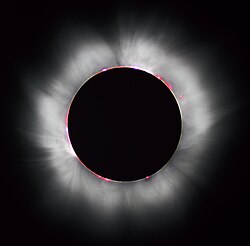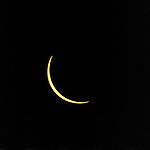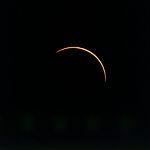Solar eclipse - Simple English Wikipedia, the free encyclopedia

As seen from Earth, a solar eclipse /ee-klips/ happens when the Moon is directly between the Earth and the Sun. This makes the Moon fully or partially (partly) cover the sun. Solar eclipses can only happen during a new moon. Every year there are about two solar eclipses. Sometimes there are even five solar eclipses in a year. However, only two of these can be total solar eclipses,[1][2] and often a year will pass without a total eclipse.
The area in which an eclipse is total is only a narrow track along the Earth. Totality lasts only a few minutes. Outside this path, all eclipses are partial, and places far from the track get no eclipse at all. The track can be predicted many years before it happens.
A total solar eclipse is a natural phenomenon (event). Long ago, solar eclipses were thought to happen because of something supernatural or as a sign that something bad was going to happen. This is still believed in some cultures today. A total solar eclipse can frighten people who do not know what it means, because the Sun seems to disappear during the day and the sky turns dark in just a few minutes. Other people like to go to the eclipse path for a good view.
Solar eclipses happen somewhere on Earth almost every year, and very similar solar eclipses happen every 18 years, 11.3 days. This period is called the Saros cycle.
Types[change | change source]

There are four different types of solar eclipses:
- A total eclipse is when the Sun is completely hidden behind the Moon. The dark shadow of the Moon covers the very bright surface of the Sun. This makes the corona easier to see.
- An annular eclipse is when the Sun is directly behind the moon, but it looks like the Moon is smaller. This makes the Sun appear as a very bright ring or annulus around the shape of the Moon.
- A hybrid eclipse (also called annular/total eclipse) is when it looks like a total eclipse in some parts of the Earth, and an annular eclipse in other parts. Hybrid eclipses do not happen as often as other eclipses.
- A partial eclipse is when the moon is not exactly between the Sun and Earth, so it does not hide the Sun completely. This can usually be seen from a large part of the Earth.
The Sun's distance from the Earth is about 400 times the Moon's distance, and the Sun's diameter is about 400 times as big as the Moon's. This is why the Sun and Moon seem to be about the same size from Earth.
Looking at a solar eclipse[change | change source]
Looking directly at the bright surface of the Sun itself can hurt the retina of the eye greatly because of the radiation that comes from the Sun. It can even blind people. The retina does not feel pain, so damage may not be felt for hours.[3]
The Sun is usually so bright that it is hard to look at it directly. However, when the Sun is covered in an eclipse, it is easier to look at it. Looking at the Sun during an eclipse is equally dangerous, except in the very short time when the Sun's surface is completely covered. Looking at the Sun's surface through binoculars, a telescope, or even a camera is extremely dangerous and can damage the eye in less than a second.[4][5]
Looking at the Sun without an eclipse does not usually hurt the eye very greatly, because the pupil of the eye closes down and makes everything darker. If the Sun is almost completely covered, the pupil opens because there is not as much light. However, the parts of the Sun that can be seen are still equally bright, and can hurt the eye very much.
Related pages[change | change source]
References[change | change source]
- ↑ Littmann, Mark; Fred Espenak, Ken Willcox (2008). Totality: Eclipses of the Sun. Oxford University Press. pp. 18–19. ISBN 978-0199532094.
- ↑ Five solar eclipses occurred in 1935. NASA (6 September 2009). "Five Millennium Catalog of Solar Eclipses". NASA Eclipse Web Site. Fred Espenak, Project and Website Manager. Retrieved 26 January 2010.
- ↑ F. Espenak. "Eye Safety During Solar Eclipses". Archived from the original on 2012-07-16. Retrieved 2011-03-18.
- ↑ A. M. MacRobert. "How to Watch a Partial Solar Eclipse Safely". Sky & Telescope magazine. Archived from the original on 2007-08-25. Retrieved 2007-08-04.
- ↑ B. Ralph Chou, MSc, OD. "Eye safety during solar eclipses". National Aeronautics and Space Administration. Retrieved 2010-12-03.
{{cite web}}: CS1 maint: multiple names: authors list (link)
Other websites[change | change source]
- Solar eclipse of January 15, 2010, Fred Espenak, NASA
- Detailed eclipse explanations and predictions, Hermit Eclipse
- Prof. Druckmüller's eclipse photography site
- World Atlas of Solar Eclipse Paths Archived 2012-07-14 at Archive.today, Fred Espenak
- Solar eclipse time sequence Archived 2017-09-29 at the Wayback Machine
- NASA's Eclipse Home Page Archived 2012-12-05 at Archive.today, Fred Espenak
- Animated maps of past and future solar eclipses Archived 2009-05-30 at the Wayback Machine
- Search among the 11,898 solar eclipses over five millennium and display interactive maps
- Looking Back at an Eclipsed Earth 1999 August 11 from Mir EO-27 - Astronomy Picture of the Day 10 June 2007
- Animated explanation of the mechanics of a solar eclipse Archived 2011-08-21 at the Wayback Machine, University of Glamorgan
- Eclipse Image Gallery at The World at Night Archived 2016-10-15 at the Wayback Machine
Eye safety[change | change source]
- Eye Safety During Solar Eclipses Archived 2012-07-16 at Archive.today, F. Espenak (NASA Goddard Space Flight Center)
- How to Watch a Partial Solar Eclipse Safely Archived 2006-03-16 at the Wayback Machine, A. M. MacRobert (Sky & Telescope magazine)
- UK hospitals assess eye damage after solar eclipse, British Medical Journal, August 21, 1999, p. 319–469


 French
French Deutsch
Deutsch





